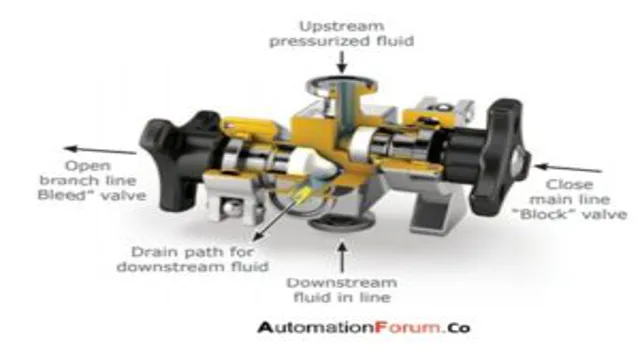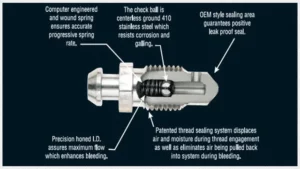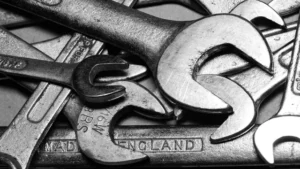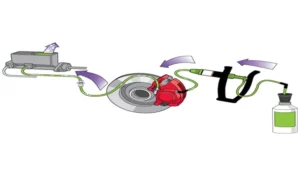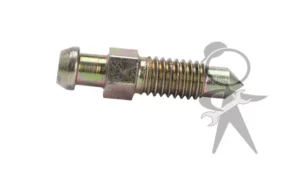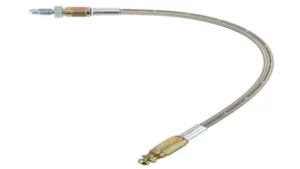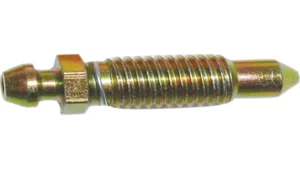When it comes to maintaining your vehicle, one of the most important components to check is the brake system. Faulty brakes can result in accidents, which is why it’s essential to make sure they are functioning correctly. One significant aspect of brake maintenance is bleeding the brake system, which involves removing air bubbles that have been trapped inside the brake lines.
Brake bleeding is usually performed with the help of a brake bleeder valve, a tool that has become vital for every car owner. But how exactly does a brake bleeder valve work? Let’s dive into the details!
Introduction
If you’re wondering “how does a brake bleeder valve work”, you’re not alone. This relatively simple tool is a key component in brake maintenance and repair. Essentially, a brake bleeder valve allows you to remove any trapped air from your brake lines, which can cause sponginess or drag in your braking system.
To use the tool, you attach it to the brake caliper or wheel cylinder and open the valve. As you pump the brake pedal or lever, the air bubbles are forced out through the valve, and fresh brake fluid can fill the void. This ensures that your brakes operate smoothly and efficiently.
Without a functioning bleeder valve, you risk reduced stopping power and potentially dangerous driving conditions. So if you’re planning on servicing your brakes, it’s important to understand the role of a brake bleeder valve and how to use it properly.
Explanation of Brake Bleeder Valve
Brake Bleeder Valve Introduction: If you’re someone who owns a car, there’s a good chance you’ve heard of the term “brake bleeder valve” in relation to your vehicle’s braking system. This component is essential for ensuring proper brake function and preventing potential safety hazards while driving. However, for those who may not be familiar with brake maintenance, the concept of a brake bleeder valve may seem confusing or overwhelming.
Put simply, a brake bleeder valve is a small, screw-like component that is located on the brake caliper or wheel cylinder of your vehicle. Its purpose is to remove any air bubbles or fluid that may have become trapped in the brake system, which can lead to a spongy or ineffective brake pedal. Without proper brake function, stopping your vehicle becomes a dangerous task.
By attaching a specialized tool to the bleeder valve and opening it, you allow brake fluid and air bubbles to escape, allowing for the system to be properly refilled and bled until all air is removed. This ensures a firm, responsive brake pedal and peace of mind while on the road. So, the next time you hear the term “brake bleeder valve,” remember that it’s a crucial part of your car’s safety system and ensures your ability to come to a safe stop.
If you’re unsure if your vehicle’s brake system has been properly bled, it’s always a good idea to consult with a professional mechanic to ensure your safety.
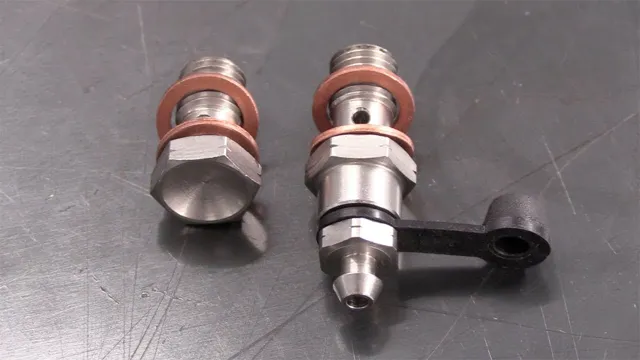
Purpose of Brake Bleeder Valve
The brake bleeder valve is an essential part of any vehicle’s braking system, but what exactly is its purpose? Simply put, the brake bleeder valve is used to remove any trapped air bubbles in the brake system, ensuring that the brakes operate smoothly and efficiently. When air gets into the brake lines, it can cause the brakes to feel spongy or unresponsive, which can be dangerous when driving. But by using the brake bleeder valve, a mechanic can release any air pockets and replace them with fresh brake fluid, resulting in a much safer and more effective braking system.
So next time you take your car in for servicing, make sure your mechanic performs a brake bleed to keep you and your passengers safe on the road.
How it Works
If you’re wondering how a brake bleeder valve works, you’re not alone. A brake bleeder valve is an essential component of your vehicle’s braking system. Its primary purpose is to remove any air that may have entered the brake lines, as air bubbles can cause your brakes to malfunction.
The brake bleeder valve works by allowing you to compress the brake fluid, forcing any air pockets out of the system. This is done by creating a vacuum, which pulls air bubbles out of the brake lines and into the valve. Once the air bubbles have been removed, you can seal the valve and test your brakes to ensure they are functioning correctly.
It’s important to keep your brake bleeder valve clean and well-maintained, as a malfunctioning valve can cause serious problems while you’re on the road. So, if you want to keep your brakes in tip-top shape, make sure you understand how your brake bleeder valve works and take care of it accordingly.
Step-by-Step Guide to Bleed Brakes
Bleeding brakes can be a daunting task, but understanding how it works can make the process easier. To put it simply, brake bleeding involves removing air bubbles from the brake lines that can cause the brakes to feel spongy or unresponsive. When you push on the brake pedal, the brake fluid travels through the brake lines to apply pressure and bring the vehicle to a stop.
If air gets into the brake lines, it can cause the brake fluid to compress, reducing the amount of force that the brake pedal can apply to the brakes. This is why it’s important to bleed the brakes regularly to ensure that they are functioning properly. Bleeding brakes involves opening each of the bleeder valves on the calipers or wheel cylinders one at a time and allowing the brake fluid to flow out until all of the air bubbles are removed.
It’s important to follow the manufacturer’s recommended procedure for bleeding brakes to avoid damaging the brake system. With a little bit of practice and attention to detail, anyone can learn to bleed their own brakes and ensure their safety on the road.
Vacuum Brake Bleeder vs Manual Brake Bleeder
When it comes to bleeding brakes, there are two main methods: vacuum brake bleeding and manual brake bleeding. Both techniques aim to remove any air bubbles from the brake system, which can cause reduced brake performance or a spongy brake pedal feel. So, how exactly do these brake bleeders work? A vacuum brake bleeder uses negative pressure to extract the air from the brake lines.
This is done by attaching the bleeder tool to the brake caliper or wheel cylinder and creating a vacuum. The vacuum then pulls the brake fluid through the system, removing any air bubbles in the process. The benefit of using a vacuum brake bleeder is that it’s a one-person job and generally quicker than manual brake bleeding.
On the other hand, manual brake bleeding uses the brake pedal to push the fluid through the system and expel any air bubbles. The process usually involves a second person to pump the pedal while the bleeder valve is opened, allowing the air to escape. This process can take longer and requires more effort than vacuum brake bleeding, but some mechanics prefer it as they feel they have more control over the process.
As you can see, both vacuum brake bleeding and manual brake bleeding have their pros and cons. Ultimately, the choice between the two comes down to personal preference and convenience. Regardless of the method you choose, make sure you bleed your brakes regularly to maintain optimum brake performance and safety on the road.
Benefits of Using a Brake Bleeder Valve
If you’re wondering how does a brake bleeder valve work, it’s actually a simple but crucial component in maintaining your car’s brake system. Essentially, the brake bleeder valve allows a technician to manually remove any air bubbles or trapped air within the brake lines. Once air enters the brake lines, it can cause the brake pedal to feel spongy or unresponsive, which compromises the effectiveness of your brakes.
By using a brake bleeder valve, you’re able to ensure that your brake lines remain filled with fluid only, which maximizes the responsiveness of your brake system. Additionally, a brake bleeder valve can help you identify any leaks or other issues within the brake lines, allowing you to address these problems before they compromise your safety on the road. Overall, using a brake bleeder valve as part of your regular car maintenance routine can help you ensure that your vehicle is as safe and reliable as possible.
Improved Brake Performance
Brake Bleeder Valve Taking care of your vehicle’s braking system is vital for your safety on the road. One effective way to improve brake performance is by using a brake bleeder valve. This small, yet efficient tool helps to remove air from the brake lines and system, ensuring that the fluid flows smoothly and your brakes work efficiently.
By using a brake bleeder valve, you can prevent problems such as a spongy brake pedal, reduced stopping power, and even brake failure. Moreover, it also enables you to maintain and change brake fluid easily, reducing the risk of contamination and brake system corrosion. Installing a brake bleeder valve is a simple and affordable solution that can ultimately save your life.
So, if you want to ensure smooth and safe braking performance for your vehicle, consider using a brake bleeder valve.
Efficient Brakes Maintenance
Maintaining the brakes of your vehicle is crucial to ensure your safety on the road. One of the essential tools that every car owner should have in their toolkit is the brake bleeder valve. This valve helps to expel air bubbles and impurities from the braking system, ensuring that the brakes function efficiently.
When air bubbles get trapped in the brake lines, it can cause a spongy or unresponsive pedal, making it unsafe to drive. By using a brake bleeder valve regularly, especially after brake repairs and routine maintenance, you can eliminate these air bubbles. This tool helps to prolong the life of your braking system, prevent premature wear and tear, and save you costly repairs in the long run.
With a brake bleeder valve, you can maintain your brakes with ease and ensure your safety on the road.
Increased Safety
When it comes to vehicle maintenance, safety should be a top priority. This is where brake bleeders come in handy. They help remove air bubbles and old, contaminated brake fluid from the braking system, ensuring better stopping power and increased safety on the road.
Using a brake bleeder valve can also help prolong the life of your brake system by preventing corrosion and rust buildup. Without regular maintenance, brakes can become less effective and even fail completely, leading to dangerous situations on the road. By using a brake bleeder valve, you can rest assured that your braking system is in top condition and ready to keep you and your vehicle safe.
So, don’t overlook this simple yet essential maintenance task, and prioritize your safety on the road.
Conclusion
In summary, a brake bleeder valve works by using atmospheric pressure to push air and old brake fluid out of your brake lines, making your brakes function more efficiently. It’s like a little buddy that’s always there to help you stop, giving you the confidence to brake late and leave all your worries behind. So the next time you hit the brakes, take a moment to appreciate the humble bleeder valve doing its part to keep you safe on the road.
“
FAQs
What is a brake bleeder valve?
A brake bleeder valve is a small valve located on a brake system that allows air to be released from the system.
How does a brake bleeder valve work?
A brake bleeder valve works by creating a vacuum which pulls air and fluid out of the brake system and replaces it with clean fluid.
Why is it important to bleed your brakes?
Bleeding your brakes is important because air bubbles in the brake lines can cause the brakes to fail, making them less effective and increasing the risk of an accident.
Can I bleed my own brakes?
Yes, you can bleed your own brakes with the proper tools and knowledge. However, it’s important to follow the manufacturer’s instructions and safety precautions to prevent injury.
How often should I bleed my brakes?
It’s recommended to bleed your brakes every 2-3 years, or more frequently if you notice any problems with your braking system, such as spongy or less responsive brakes.
What are the signs that my brakes need to be bled?
Signs that your brakes need to be bled include a spongy or soft brake pedal, decreased brake performance, and a longer than usual stopping distance.
Can I use a vacuum pump to bleed my brakes?
Yes, a vacuum pump can be used to bleed brakes, and it’s a popular method because it’s easy and convenient. However, it’s important to use the right type of vacuum pump and follow the manufacturer’s instructions to avoid damaging the brake system.
